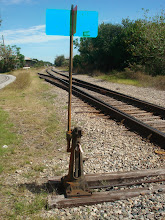This module will join the right end of the Tarragona St. module. It includes a right hand turnout diverging onto Main St. and a little farther south another right hand turnout that splits the line into two tracks before crossing Main St. The yard itself is just south of Main St. and, except for this one section of trackage is all south of the street. In earlier years another track split off the curve that diverges onto Main St. to lead into another side of the yard that has since been removed. That was called the "Low side" and also reached tracks that served an oil terminal with several large storage tanks and had a switcback to tracks that reached up side streets between old brick warehouses just west of the yard. Sadly I never took any photos of these tracks in my early years of railfanning. Also, one of the warehouses has been torn down ...I suspect due to hurricane related damage received in recent years. I am not planning to include the Low Side tracks in my model as rail traffic to the Low Side in later years was very little and including it would increase the width of the Port module more than I want.
The turnout that splits the downtown spur into two tracks before entering the port yard is just north of Main St. The turnout to the Main St. interchange track was located about a half block north of this turnout. Unlike the other turnouts in Tarragona St. this one is not embedded in pavement. This view looks north up Tarragona St.
.JPG) This view is looking south from approximately the same spot as the previous photo. The yard ladders can be seen with the Pensacola Port facilities in the background. The rubber grade crossings were not in place in the late 80s era I'm modeling. A model of the warehouse in the distance is planned for the port yard module.
This view is looking south from approximately the same spot as the previous photo. The yard ladders can be seen with the Pensacola Port facilities in the background. The rubber grade crossings were not in place in the late 80s era I'm modeling. A model of the warehouse in the distance is planned for the port yard module..JPG) This building is on the east side of Tarragona St. adjacent to the turnout in the middle of the street. It housed the Pensacola Transportation Museum in the 1980s and looked essentially the same as it does here. The northwest corner of this building can just be seen in the view of the turnout two photos above. The two tracks crossing Main St. are leading into the yard to the right of this view.
This building is on the east side of Tarragona St. adjacent to the turnout in the middle of the street. It housed the Pensacola Transportation Museum in the 1980s and looked essentially the same as it does here. The northwest corner of this building can just be seen in the view of the turnout two photos above. The two tracks crossing Main St. are leading into the yard to the right of this view..JPG) The office building in this photo is west of Tarragona St. on the north side of Main St. You are looking at the southeast corner of the building. Though the tracks are no longer there it was on the inside (north) of the tracks that curved onto Main St. A compressed version of this building will be included on the module. If memory serves, the courtyard and lamps are newer additions and will not be included in the period model.
The office building in this photo is west of Tarragona St. on the north side of Main St. You are looking at the southeast corner of the building. Though the tracks are no longer there it was on the inside (north) of the tracks that curved onto Main St. A compressed version of this building will be included on the module. If memory serves, the courtyard and lamps are newer additions and will not be included in the period model..JPG) This building is on the south side of Main St. across from the building pictured above. This is the east elevation and the building in the previous photo above is across the street to the right out of view in this photo. The street you see here is Commendencia St. A much compressed version of this building is planned for inclusion on this module.
This building is on the south side of Main St. across from the building pictured above. This is the east elevation and the building in the previous photo above is across the street to the right out of view in this photo. The street you see here is Commendencia St. A much compressed version of this building is planned for inclusion on this module..JPG)
.JPG)

.JPG)
.JPG)
.JPG)
.JPG)
.JPG)
+(Medium).JPG)
